- Active Investing - what is it?
- All Weather Trading Plan using Complex Theory (Parts 1 - 4)
- Asset Management (Parts 1 - 4)
- Back Testing
- Breaking out from consolidation
- Breakout trading in all market conditions
- Charting in a Nutshell
- Children of the Bear
- Fibonacci and the Golden Ratio
- Going Public
- Hull Moving Average
- MACD Breakout Trading (Parts 1 - 2)
- Making decisions with a Simple Moving Average
- Probability: do you have the stomach for it?
- Profit Taking
- Relative Strength
- Record Keeping
- Risky Business
- Short Selling
- Social Media Bubble
- Switching Gears
- Rate of Return indicator
- Time and Money
- Tools of the Trade
- Trade Warrants (Parts 1 - 4)
- Trading without spending money
- Trendlines
- Triangles
- GMMA's on Weekly Charts
- Writing Custom Indicators
Articles include:
This article is an extract from Alan Hull's bestselling book, 'Blue Chip Investing'.
The word 'Invest' actually means to, 'Apply or use money for profit' which includes any money making endeavour which requires money. So to describe yourself as an investor could mean that you've had to spend money to start your own business, you're a property investor or even a Tradesman who owns his own tools. Hence the tag, 'Investor' is not a very useful definition...
However the word 'Trade' means, 'Buying and selling for profit' which does make for a useful definition. If I say I am a share trader then I am stating that I buy and sell shares for a profit, which sounds ridiculously simple, but there are deeper implications to this statement. For instance, if I am buying shares with the intention to sell them at a future date for a profit then they must be rising in value. The funds management industry refers to this type of share as a 'Growth stock' because, hopefully, the share price will grow over time.
A share trader qualifies as a type of investor because they are applying money to the Stockmarket in order to generate a profit. Contrary to popular belief, a person who deals in shares is not defined as a 'Trader' by the number of trades they perform each year. A certain Government department created this definition and, whilst it may serve their purposes well, it is very misleading for the rest of us. If you purchase a share with the intention to sell it at anytime in the future for a profit then you are a share trader. The value of the share must go up over time and you could sell it after 1 week, 1 year, 10 years or even longer.
If we define a share investor as someone other than a share trader then I think it would be reasonable to take the World renowned Investor, Warren Buffet's, definition of an investor as being an 'Asset manager'. Warren Buffett's company, Berkshire Hathaway, is an asset management company, which buys interests in companies that are undervalued, improves their operation over time and then derives a very cost effective income from them. Warren Buffett's favourite holding time is forever because he buys interests in companies in order to derive an ongoing income and not to buy and sell them.
In other words, he's primarily after a share of the profits and he views any capital growth as a bonus. In order to make use of any capital growth he will borrow against it rather than sell his holdings, which will attract capital gains tax. Unlike a share trader who will sell shares that start to fall in value, Warren will buy more shares because they represent a cheaper income stream. So a share trader wants to buy a rising share price and an Investor (read asset manager) wants to buy a high-income yield, which occurs, when the share price falls... perfectly opposed objectives!
- Assume that a company pays an annual dividend of $1.00 and the share price is $10.00
- Hence the dividend yield or income yield = $1.00 / $10.00 = 10% per annum.
- Now let's assume the share price drops to $8.00 but the dividend remains at $1.00 p.a., a not unlikely occurrence given that a company's profitability isn't necessarily linked to its share price.
- Therefore the dividend yield would increase to = $1.00 / $8.00 = 12.5% per annum
Numeric Example
So if you're looking to buy a high yielding stock, referred to by the funds management industry as an, 'Income Stock', then the direction of the share price is largely irrelevant because, like Warren, you have no intention of selling the share at a later date. In fact if the share price was to halve during a Stockmarket crash you would buy more shares because the yield will have doubled. This is where 'Dollar cost averaging' is used very effectively because you keep buying more shares as the share price drops and the dividend yield keeps rising, thus averaging up your income. Hence dollar cost averaging is a very effective technique for investors such as Warren.
Now let's turn our attention to real estate investment and look at how property can be either bought and sold for a profit or held as an income producing asset, just like shares. I'll use a real world example here because recent developments in the property market will prove very illustrative. As many property investors are aware there is a large population of baby boomers who are just around the corner from retirement. It has been broadly assumed that this particular demographic are shortly going to sell up their family homes, once the children have vacated, and retire on masse to locations more suited to a leisurely lifestyle than the suburbs.
Hence the massive investment in, and development of, inner city apartments we've seen in Australia since the turn of the millennium. Now assume for a moment that you're an investor who is currently in possession of an inner city dwelling and you have to make a command decision as to whether you should retain the property for the rental income or sell it outright for a profit. Given the expected migration of the baby boomers to the city, we know that if we sell into the resulting demand then we can reasonably expect to make a good profit on the sale.
But what are our prospects if we want to retain the property indefinitely for the income stream? Not too good I expect because the baby boomers who are heading for the big smoke are going to be seriously cashed up, having sold the family home, and looking to buy their own apartments rather than fork out rent to someone else. So given this particular scenario it would be my opinion that trading the apartment for a profit will probably prove more prudent than holding it for the long term as an income producing asset... remember this is just my opinion.
So given the opposed perspectives of traders and investors, you can appreciate the importance of knowing which category you belong to. My preferred approach to the Stockmarket is to trade shares whilst I consider real estate to be superior to shares as a lifetime income producing asset. Shares are an intangible product, which makes them ideal to trade in because they don't require any infrastructure. I don't have to physically take possession of the shares, they don't require maintenance and there is always a ready market of buyers and sellers. On the other hand I'm not too fond of shares as lifetime income producing assets because there's no guarantee that the companies which the shares represent will be around for my lifetime.
Property on the other hand isn't about to be sold out from under me because some board of directors, that I have no influence over, think it's a good idea. What's more property is typically more stable in terms of its income revenue and the banks are far more user friendly when it comes to gearing a property portfolio than they are a share portfolio. But buying and selling the family home was enough of a saga without making a business out of it by trading in investment properties... imagine the headaches. Hence, while there is the odd exception such as buying and selling inner city apartments, my preferences are to trade shares and invest in property.
Now that we're clear on what we mean by the word, 'Invest' we can move on to the next part of this discussion and that is the word, 'Risk'. We'll start with a quantitative definition;
Risk is the product of the possibility of incurring a loss and the potential magnitude of the loss.
In other words the risk of dying in a motorcar accident is the probability of being in a car accident multiplied by the probability of dying in a car accident. Therefore, if your chances of being in a car accident were 1 in 100 and the probability of dying in a car accident were 1 in 1,000 car accidents then the probability of dying in a car accident would be 1 in 100,000.
Interestingly, many academic studies have shown that mankind's greatest fear is 'Fear of the unknown'. In other words if we can't quantify a risk then our imaginations take over and we fear the worst. Hence Stockmarket's around the world dropped dramatically in the lead up to the first gulf war, only to recover just as rapidly once the actual hostilities broke out...thus bad news is better than no news.
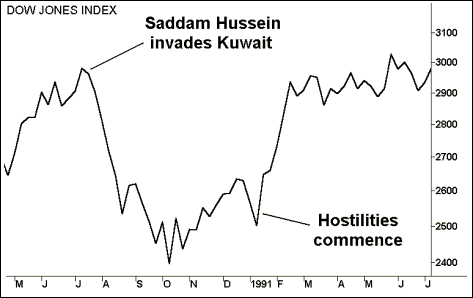
If we can't measure the risk or we don't understand the risk then we can only perceive the risk and this is a qualitative form of analysis. Qualitative risk is ruled by our emotions and/or imagination and is largely erroneous as some university researchers have discovered through their investigations of the human state of worry. By measuring the actual outcomes of things we worry about they determined that only 2% of what we worry about actually comes to pass.
But erroneous or not, perceived risk has the power to either prevent us from taking action at all or, more commonly, impede our ability to act objectively. Therefore we need to eliminate this form of risk and the best way to do this is with knowledge. If we fear the unknown then the best course of action is to eliminate it through education. For example, I'm an electronic technician by trade and as such I wouldn't hesitate to pull the back off a television set or any other electrical appliance. But the idea of organising a dinner party fills me with dread because of my very limited knowledge of cooking... I would definitely run the risk of poisoning someone.
Many investors perceive imaginary risks (what I refer to as qualitative risk) that they consider being beyond their control because they have never been exposed to the quantitative science of risk management. Risk management is the assessment and control of risk. The best way to explain how it works is by using a real world example.
Assessing Risk
Let's assume we're playing a game of coin toss where the probability of losing each game is 50%. In other words it's a fair game of chance where the outcome is even with respect to getting a head or a tail. If we play 100 games of coin toss then we can create a chart showing the balance of outcomes for 100 consecutive tosses of a coin as shown below.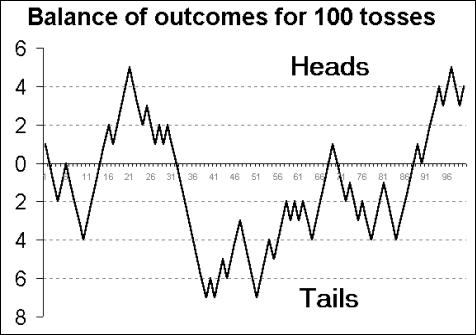
Although tossing a coin only 100 times is certainly not a conclusive exercise, it will serve our purpose well which is to measure the maximum possible loss we face when tossing a coin. We know the balance of outcomes for a fair game of chance will always return to zero because the outcomes are even and, from the above chart, we can see if we were betting on heads that the greatest loss we can expect to encounter is to be 7 tosses down. Therefore the probable outcome of this game is to break even while we risk suffering a maximum loss of 7 tosses, 3 times in every 100 tosses.
Controlling Risk
This is the easy bit... if we were wagering 1 dollar on each toss of the coin then to cope with the risk we simply need to make sure we've got at least 8 dollars to play with at the start. (1 more than 7 because you need at least $1 in your possession in order to keep playing) Hence this will ensure our survival and we'll live long enough to enjoy the outcome of breaking even. Luckily for us the Stockmarket offers a much better outcome than just 50/50...Share Trading
This is the good bit... given that the All Ordinaries Index, the Australian Stockmarket Index, has risen 9% per annum on average for the past 100 years, the outcome from even random Blue Chip share selection would be 9% capital growth plus the average dividend yield of the Index. (Of course please note that while past performance is our best guide in most instances, it is no guarantee of future performance... a point rightly made in many an investment prospectus.) The following chart is an 11-year snapshot of the All Ordinaries, from the years 1990 to 2000.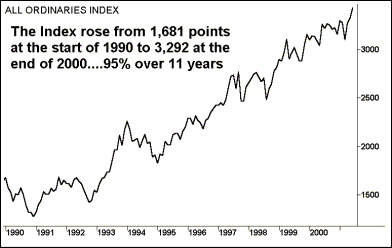
But, as with the game of coin toss, share traders can expect to incur significant losses from time to time such as during 2002 when the All Ordinaries Index dropped 11%, as shown below.
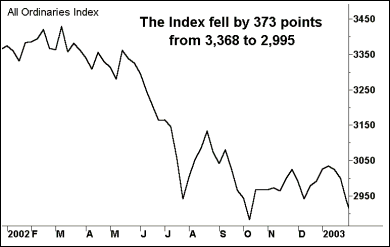
So whilst our frame of reference in the Stockmarket is 9% per annum in our favour over the long term, we need to make sure that we can survive long enough to enjoy it. Hence, in order to control the risks involved in share trading, we need a way of ensuring our sustainability. This is achieved by regulating the size of our losses.
First, let's assume we are going to start trading shares with a total capital of $50,000 (the value of our share portfolio plus any cash reserves) and we will lose $5,000 on each share we trade. So after 10 consecutive losing trades we would be wiped out... not a very nice prospect. Now consider a slight variation on this theme where we only put at risk 10% of our current total capital. The following table shows how our losses would become smaller with each losing trade. Note that once again we are starting with shares and cash worth a total of $50,000.
| Loss | Amount lost | Total Capital after the loss |
| 1 | $5,000 | $45,000 |
| 2 | $4,500 | $40,500 |
| 3 | $4,050 | $36,450 |
| 4 | $3,645 | $32,805 |
| 5 | $3,280.50 | $29,524.50 |
| 6 | $2,952.45 | $26,572.05 |
| 7 | $2,657.20 | $23,914.84 |
| 8 | $2,391.48 | $21,523.36 |
This method of regulating our losses will increase our sustainability considerably by more than doubling the number of losses it would take to wipe us out. In fact if we were to call it quits once we had reduced our initial bank of $50,000 down to $5,000 then we could sustain up to 23 consecutive losses. This deterioration of $50,000 can be seen graphically in the following chart which compares using a 10% reducing loss with a 2% reducing loss.
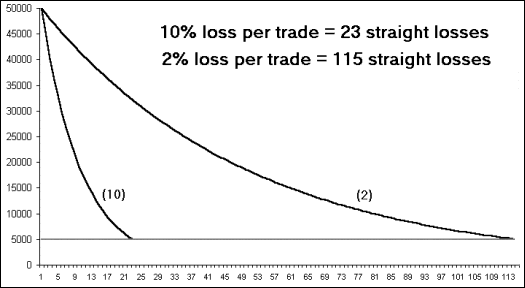
The 2% Risk Rule
No first prizes for guessing which percentage successful share traders use. A 2% reducing loss enables us to sustain in excess of 100 consecutive losses. Here's a tip; if you ever get to 100 consecutive losses then immediately stop trading and withdraw from the Stockmarket, whatever you're doing obviously isn't working.We call this risk control method the '2% risk rule' and it states; Never risk more than 2% of total capital on any individual trade.
I use the 2% risk rule to manage my own DIY Superannuation portfolio and my 9 year old daughter's training portfolio which is worth under $10,000 and I stuck to it faithfully when I was managing other peoples retirement savings valued in the tens of Millions of dollars.
And don't fall for the trap of thinking that a 1% risk rule would be better than the 2% risk rule. Using 1% leads to other problems such as over-diversification, which will hamper performance and increase management costs such as brokerage fees, etc. Hence, I generally find that 2% provides the optimal balance between risk control and portfolio diversification.
Assess or Control
Unfortunately we can't apply the 2% risk rule to the property market because it operates on a totally different dynamic to the Stockmarket. When a property investment goes astray then we usually find that we suffer a loss of time as opposed to a loss of money.This is because we are very much inclined towards riding out a drawdown in the value of our property rather than cutting our losses. This makes sense given that 'Cutting our losses' in the property market involves a lot more than just calling up our Stockbroker and placing a sell order.
So risk management in the property market leans far more strongly towards risk assessment than risk control. Hence, a property investor mostly manages their risk by assessing all the relevant factors such as the direction of interest rates, rental demand, etc, before entering the market whereas a share trader manages risk by regulating their losses after they're in the market.
Keep it Simple
The final point I want to make on risk management is the need to avoid complexity. As a young computer technician I was taught a repair technique referred to as, 'The plain vanilla approach'. In order to repair a PC, the first step was to strip it down to the bear essentials and see if just the key components would work by themselves.By eliminating as many variables as possible, I could quickly and easily get to the heart of the problem. I have found in later life that the plain vanilla approach is applicable to pursuits other than just fixing PC's... investing and trading being among them. Putting it succinctly... if you can't get your head around it then don't do it. Or putting it another way;
If it doesn't work simply then it simply doesn't work.
'Keep it simple', is a commonly used cliché among share traders for a very good reason... it is a key aspect of good risk management. Reducing complexity increases reliability and that's why the management control systems in modern motorcars are nowhere near as complex as the average desktop PC's are. And it's a good thing too; otherwise I would have to reboot my car at least once a day given that that's how often I usually have to reboot my office computer...